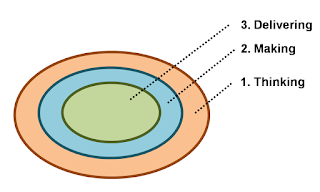In Part I we learnt that we can improve as a presenter by paying careful attention to three aspects; thinking, making and delivering. Think about what we have to say and come up with few key messages. In Part II Rangarajan talks about 'making' and covers topics like storyboarding, message, headline. If your presentation passes the 'layman' test then it is going to be a 'wow' presentation. Now we will read the third part of the series.
3. Delivering the presentation
The culmination of days/weeks of hard work is almost here. Today is presentation day. The way you deliver your presentation today will determine whether your audience thinks of your effort as ‘oh-wow!’ or ‘umm-what?’ As a presenter or presenting team, what can you do to ensure that your chances of creating a ‘wow’ impact are increased?
Planning: The first thing to do is to plan the delivery of the presentation thoroughly. The following aspects are very important:
A. Understand the audience:
- Who all are going to be present for the session? What are their backgrounds? What are their personal agendas likely to be?
- Who is the key decision maker in the group?
- Who is the change leader?
- Who is the change resister?
- What are the likely arguments that the change resister can put forth?
You would have probably gleaned most of these bits of information from prior interactions/discussions. Ensure that you discuss these aspects with your team members and prepare lines of attack/defence well before the presentation starts.
B. Understand the presenting team: Most presentations are not one-man shows. There will be a team of people from the presenting side. Even if the final presentation is delivered by one person, the Q&A sessions during and after presentations are usually handled by team effort. Pay attention to small things that go a long way in ensuring a high-impact team performance:
- Demarcation of areas: Clearly assigning certain sections of the presentation to your team members helps ensure more thorough research and preparation of individual sections. For example, team member A is in charge of delivering section 3, team member B is in charge of handling all questions related to area 4 etc.
- Prepping of key messages: Even when there are 4-5 bullet points in a slide, the key message is going to be just one. While this message is likely covered by the headline of the slide, written and spoken language is different. Ensure that the messages sound correct when verbalized in speech.
- Understanding strengths and weaknesses of presenting members: Some people are better at turning around ‘bad situations’ while some people are good ‘front runners’, who make a high impact when the audience is unsure but not hostile. Ensure that the strengths and weaknesses of the presenters are mapped to the sections of the presentations that you assign them with.
- Preparing Plan B: It is important to have a back-up plan in case your presentation does not go well? What do you do if the presentation does not go as well as you had hoped? Can you have some other team member deliver a section? What is your retreat option? Should you weather the storm or go for a counter-attack?
C. Understand the infrastructure: This includes some of the following aspects
- The presentation room: Where are the projectors? Where is the screen? Where will the presenting team sit? Where will the audience sit?
- Presentation materials: Does the audience need printouts? Will you have access to white-boards? Do you need to use laser pointers?
Executing the presentation: This is the final piece of the jigsaw and probably the most important one. What all do you need to do to execute a good presentation? Some of the following will help
- Posture: Adopt an easy posture that you can maintain without much difficulty for the duration of your section/sections of the presentation. Typically, an ‘at-ease’ posture works well, but keep your hands to your side instead of behind your back. Do not pace around too much during the presentation. Keep your head still and upright
- Eye-contact: Maintain eye contact steadily with all sections of your audience. The decision-maker should probably receive slightly longer eye-contact than the rest of the audience, but not much. At the end of the day, the presentation is to the audience.
- Language: Keep your sentences short and simple. Avoid jargon (imagine this coming from a consultant!).
- Speaking style: Do not speak too fast or too slow. No matter what your natural speaking style is, a presentation requires medium-paced delivery and clear enunciation. Ensure that you practice this repeatedly. Occasionally, use silence as a valuable tool to drive home your point.
- Confidence: This is the most important aspect of your delivery. You need to come across as being assured and deliberate. This comes primarily from two things – practice and knowledge. Practice refers not only to the hours put in for the current presentation, but the accumulated hours of practice you might have put in for all presentations in front of various audiences. Knowledge refers to the knowledge of the subject matter, the audience, the team and the infrastructure outlined above.
Concluding thoughts: No matter what you do with respect to thinking, making and delivering the presentation, there are some aspects that will always be beyond your control. You will have good presentations and you will have bad presentations. The important thing is to feel happy about the good ones and more importantly, learn from the bad ones. As with anything else, keep at it to become better at it.

About the Author: Rangarajan has been a consultant for over 4 years with A.T. Kearney, a leading management consultancy firm that advises CXO level executives on matters of strategic and operational importance. Prior to joining A.T. Kearney, he did his post-graduation from IIM Ahmedabad. He has given multiple presentations to the Boards/CEOs/CXOs/Senior management of many leading Indian companies and brings a wealth of practical experience in handling tough presentation situations.



